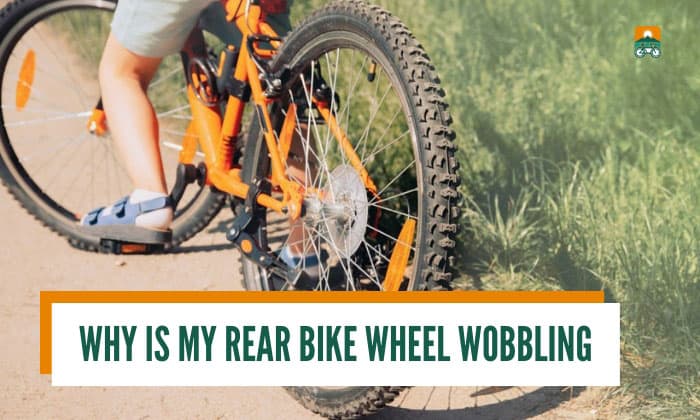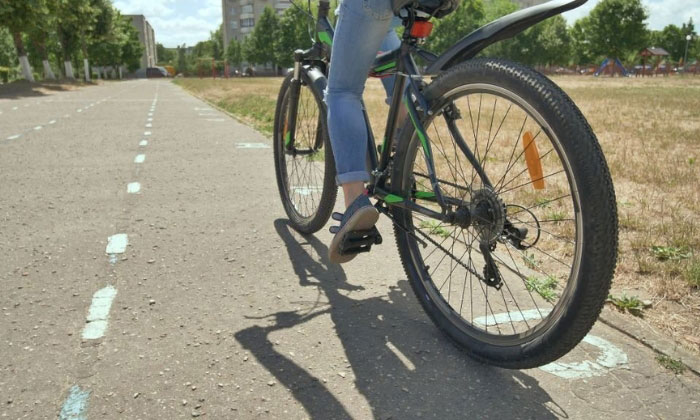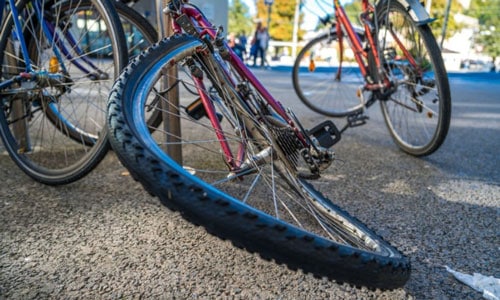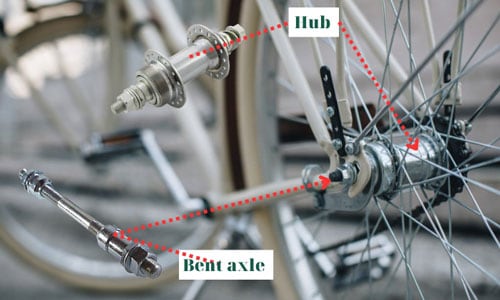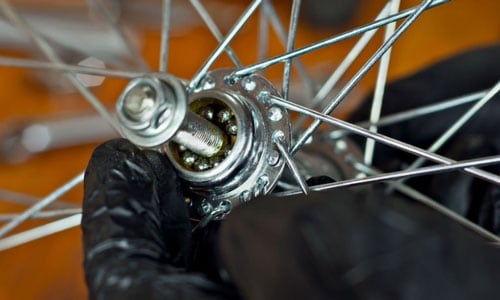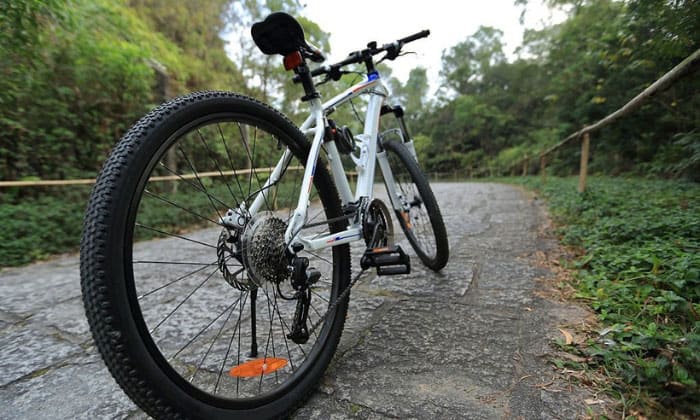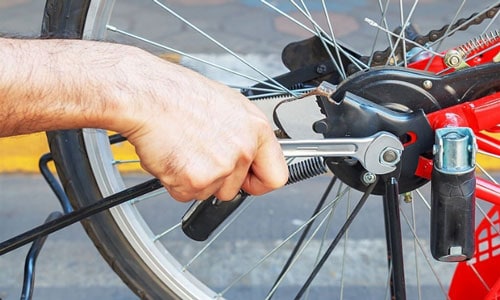Many bicycle problems may frustrate new and veteran cyclists alike. Wheel problems are of great concern because these can lead to accidents. Let’s address the question “Why is my rear bike wheel wobbling?”.
Possible reasons for this are damage to the wheel or its components, worn-out parts, or improper settings on the bicycle. Let’s delve into the specifics of the most common reasons for bike rear wheel wobble below.
Keep reading to learn more.
Table of Contents
Reasons for a Wobbly Rear Bicycle Wheel
The wheels of a bike contribute to some of the important aspects of cycling, namely stability, speed, control, and comfort. However, if the rear bicycle wheel wobbles, these things are lost, not to mention the possible risks that arise.
While such a problem can be frustrating, fixing it is doable once the cause has been identified. Many common causes of this problem are easy to find whether it’s a road or mountain bike.
The bike front wheel can wobble as well, but we’ll stick to the rear for now. Here are some of the most common reasons for a wobbly back bike wheel.
1. Incorrect Tire Pressure
A road bike tire requires 65 to 95 psi to run smoothly.
Not following this indicated pressure leads to the tire being too hard or too soft, each with its own set of problems. It is the low-pressure tire that is in our interest to learn when discussing back bike wheel wobble.
Soft tires become unstable, leading the wheel to wobble. The rear wheel is especially sensitive to this because this is where much of a cyclist’s weight rests. Damaged or worn-out tires may also cause shaking or wobbling.
Addressing tire-related problems is not all that difficult. A bicycle tire pump is all you really need to correct pressure problems.
Also, replacing worn-out tires is enough to get your bike back into shape.
2. Rim Damage
The wheel rim keeps the tire in place; thus it’s important for the rim to maintain a balanced shape, or the entire bike wheel will wobble from side to side and be difficult to control.
A bent rim is a good example of wheel damage that can cause wobbling. It can be caused by several things, including a deep pothole or heavy impact to the cycle.
Regular assessment of wheel trueness is important because it can help us identify problems early and avoid further complications such as damaged spokes.
3. Bent Axle or Hub
The hub is the center of the wheel, serving as a connection point for the spokes; it connects to the axle and is the rotation axis. And the axle secures the wheel in place. So, damage or bending of either hub or axle can cause wheel wobbling.
How do you know whether the bike wheel wobbles on axle or hub?
- For hub damage, the feeling of cycling becomes strange and it feels as if the bicycle’s turns or descent are sluggish or rough. There may also be noise from the wheel suspension or quirks to the shifting.
- Suppose you feel an uneven shifting of weight while cycling. It is probably because the axle loose, bent, or damaged. This is more evident as you pedal, and in the case of a bent axle, you can use a wrench to straighten it.
- In the case of rear wheel hub wobble; if it is loose, sometimes it is enough to tighten the axle nut to get things working properly. However, if you’re not confident about fixing the problem, it will be better to seek professional assistance and learn from watching the pros if possible.
A bike with axle problems can be dangerous, and problematic hubs may lead to the wheel detaching during use. It is recommended to refrain from using a bicycle with such issues until it is fixed. And for significant damage or wear, replace the part with a quality one.
4. Bearings Are Loose or Worn Out
Aside from loose hubs, loose or worn-out bearings can also cause the bike wheel to wobble. This applies especially to cup and cone hubs that are commonly used due to their easy maintenance.
These hubs have two main components, the cones and the cups which are separated by steel ball bearings. While this type of hub is easily maintained, it is also sensitive to improper tightness, where too much resistance will cause damage to parts, while being too loose will lead to wobbling.
If you tighten rear hub and the wobbling persists, it may be the bearings that are to blame.
If the bearings get worn out, there will also be too little resistance again, leading to wheel wobble, feeling like something is grinding when pedaling is a reliable sign of worn bearings.
If the bearings are old, it is best to replace them.
5. Spokes In Bad Condition
Spokes help the bike wheel retain its shape and stability and are constantly exposed to stress while performing their intended function. If just a few are missing, the wheel’s balance cannot be maintained, leading to wobbling.
Even if they are complete, the tightness of spokes is important to maintain the wheel’s proper form, and the stress of bicycle operation can cause things to go out of sync.
DIY Fixes for Wobbling Rear Bike Wheel
Here are steps you can take to fix a wobbly back bike wheel. You can also take these as preventive measures to address problems before they get out of hand.
1. Wheel Truing
This mainly involves adjusting the spoke tension on your wheel, and you’re best off using some tools for this.
- You’ll need a spoke wrench to adjust the tightness properly. A wheel truing stand and spoke tension meter both help but are not mandatory.
- Check to see if the wheel is true and even; if it isn’t, then it is likely that the tension is not even.
- Examine the wheel to find the source of the wobble and adjust the spokes in that area. Wobbling to the left means the right side spokes are loose, or the same side spokes are too tight, and vice versa.
- Adjust the spokes at half turns to keep it manageable. This can take a lot of time, and the tools can help make things easier. Do this regularly.
2. Tighten Loose Hubs
As mentioned earlier, loose hubs lead to wobbling, but some can be fixed by tightening using a wrench.
You’ll need to access the cones by removing the lock nuts. Carefully adjust tightness since it is easy to tighten the cones too much.
3. Regular Maintenance
Ensure that your bicycle, including your wheels, undergo regular check-ups and maintenance; this is not exactly DIY, but it is worth mentioning.
Ensure that your tune-up covers the entirety of your wheels, and things are bound to be better than worse most of the time.
Conclusion
Why is my rear bike wheel wobbling? Now you have a better idea about this question and a few things to try to get something in line. There is much to learn about keeping your bicycle in good working condition, but this is an excellent start.
When is the best time to learn about bicycle troubleshooting and maintenance? Where is the best place to start? Let us know your thoughts about this in the comments section below.
Always ride safely.

“I ride my bike to work for years, but is that enough? Our carelessness towards our surroundings has taken a toll on the environment. And now, everyone is responsible for changes; even the most minor contribution is counted. With this hope and spirit, I started with my partner to establish Biketoworkday to help more individuals commute to their work sites on their bikes.”

